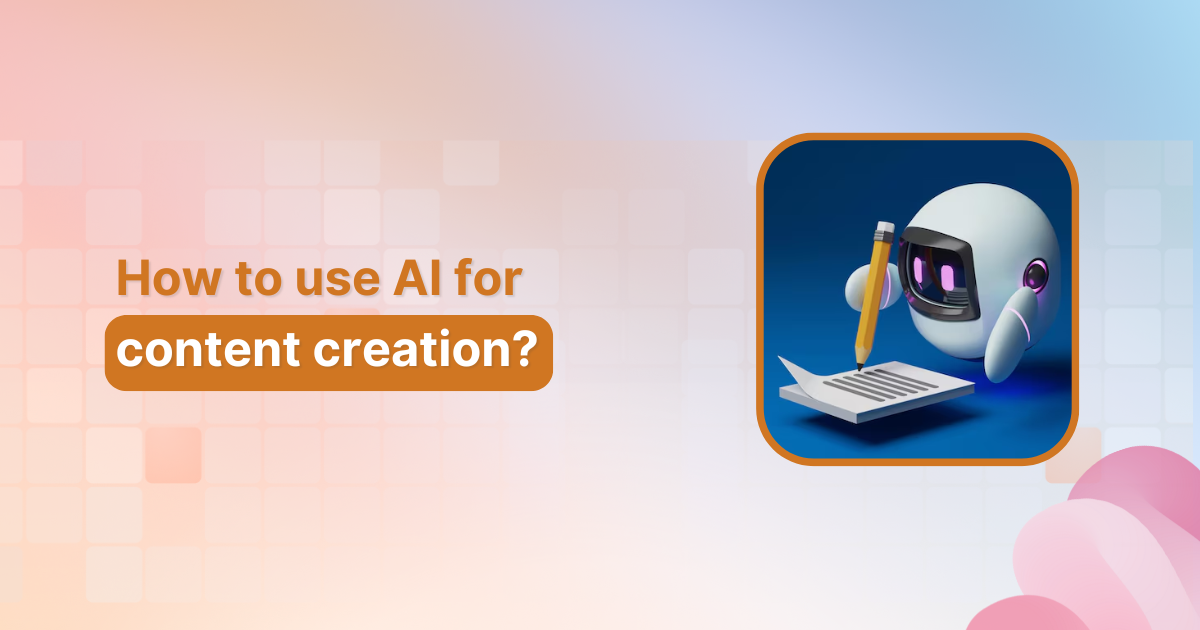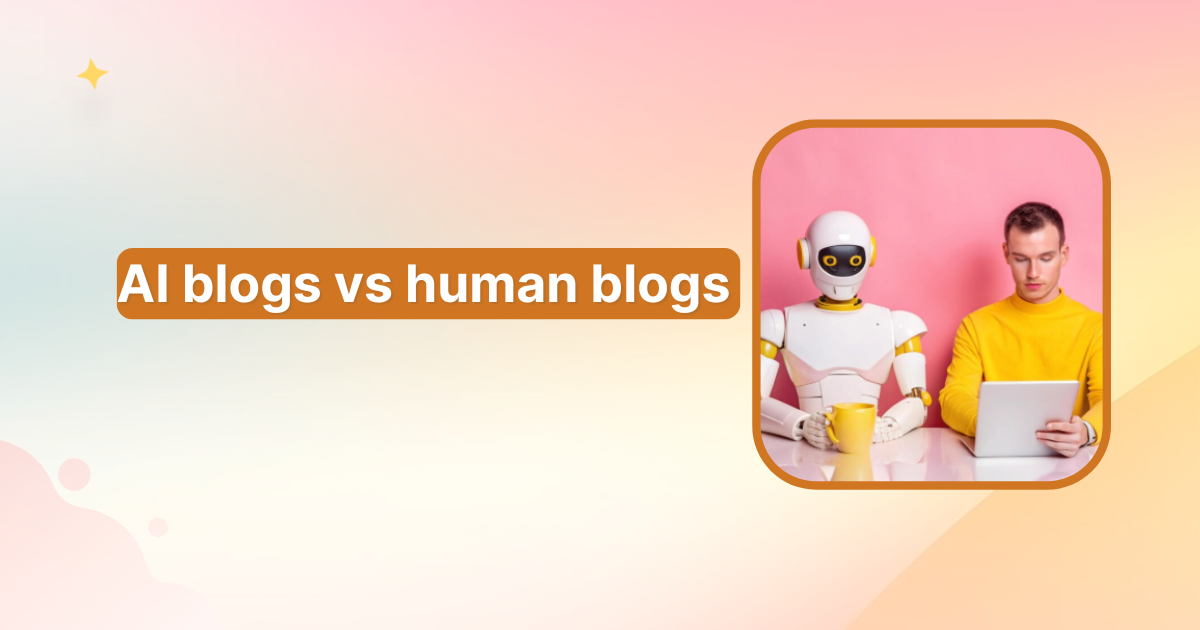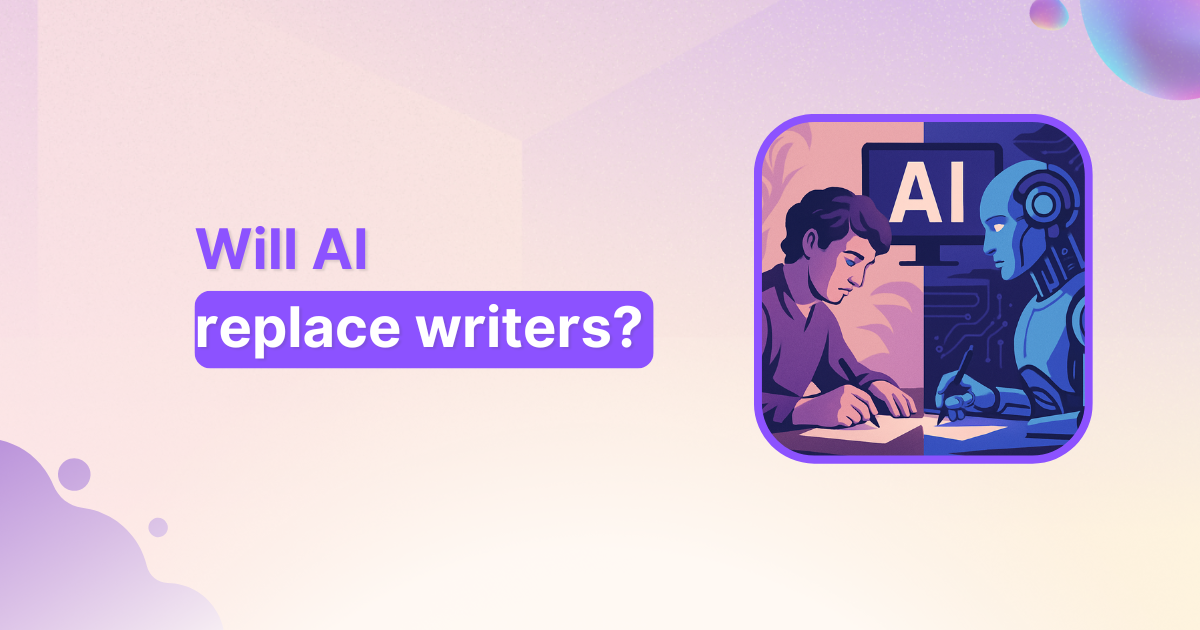How to use AI for content creation?

AI-powered content creation is changing the way businesses, marketers, and writers produce high-quality content.
By automating research, structuring, and optimization, AI-driven content creation tools help streamline the writing process while maintaining relevance and engagement.
This guide will walk you through how to use AI for content creation, covering essential steps, best practices, and optimization techniques.
How does AI work for content creation?
Content creation has traditionally been a manual process requiring extensive research, writing, and editing. However, AI has transformed this landscape by automating content generation, from ideation to final drafts. By leveraging advanced algorithms, AI-powered content creation tools can analyze vast amounts of data, understand context, and generate human-like text efficiently.
How AI analyzes data, understands context, and generates text?
At its core, AI for content creation relies on natural language processing (NLP) and machine learning to interpret text patterns and produce coherent content. These systems are trained on extensive datasets, enabling them to:
- Extract relevant information by scanning sources such as articles, reports, and search trends.
- Understand language structure and intent to create contextually accurate responses.
- Generate well-structured content that aligns with the tone and style required for different formats.
AI-powered content creation tools can analyze input prompts to produce original text that mimics human writing while maintaining clarity and relevance.
The role of AI-powered content creation in automating writing
One of the biggest advantages of AI-powered content creation is its ability to streamline writing tasks. AI can assist with:
- Generating blog posts and articles based on specific topics and keywords.
- Rewriting existing content to improve readability and engagement.
- Enhancing consistency in tone and messaging across multiple platforms.
This automation reduces the time and effort needed to create high-quality content, allowing marketers and businesses to scale their content strategies more efficiently. Modern AI blog writer goes beyond simple text generation.
Platforms like Contentpen AI integrate AI-driven capabilities to:
- Assist with SEO optimization by suggesting relevant keywords and readability improvements.
- Improve writing quality through grammar and style enhancements.
- Enable bulk content production without sacrificing consistency or engagement.
By incorporating AI content creation software into their workflows, content creators can produce high-performing content faster while maintaining accuracy and relevance.
How to use AI for content ideation and research?
Finding relevant content topics is one of the biggest challenges in content marketing. Traditional brainstorming often leads to repetitive ideas, missed opportunities, or content that doesn’t align with audience search intent.
AI content creation tools solve this problem by analyzing vast amounts of data, identifying trending topics, and suggesting content ideas that are optimized for SEO and engagement.
Businesses can streamline ideation, improve research efficiency, and develop content that resonates with their audience by using AI content creation software.
Here’s how to leverage AI for better content ideation and research.
1. Analyze trends using AI content creation software
Before selecting a topic, it’s essential to validate demand by analyzing real-time trends and audience interests. AI content creation software scans search engines, social media, and competitor content to uncover topics with high engagement potential.
- Identifies emerging trends by analyzing recent search behavior.
- Tracks competitor performance to detect content gaps.
- Monitors audience engagement to align content with what users care about.
Instead of relying on intuition, AI ensures every topic is backed by data, making content more relevant and impactful.
2. Generate high-impact topic ideas with AI
Once AI identifies trending topics, it generates content ideas that align with search intent and audience demand. This prevents businesses from creating outdated or low-performing content.
- Creates SEO-driven content topics based on keyword and search trend analysis.
- Structure topic ideas into detailed outlines for easier content creation.
- Suggests multiple content angles to differentiate from existing articles.
For example, instead of “AI content creation tools”, AI might suggest:
- “Best AI content creation tools for businesses in 2024”
- “How AI content creation software can improve content marketing results”
These AI-generated ideas ensure your content stands out and addresses specific audience needs.
3. Refine and personalize topics using an AI writer
Not all content topics are one-size-fits-all. An AI writer helps refine topic ideas by adjusting them based on audience preferences, content formats, and engagement goals.
- Optimizes headlines for higher engagement and SEO rankings.
- Recommends content formats (guides, comparisons, or listicles) based on user intent.
- Align tone and structure to match your brand voice and target audience.
For example, if AI suggests “AI writing tools”, an AI writer can refine it into:
- “Top 5 AI writing tools to streamline your content workflow” (List format)
- “How AI writing tools can help marketers improve content quality” (Educational tone)
This ensures content ideas are structured for maximum impact and user engagement.
4. Use AI-driven keyword research to validate topic potential
A great topic isn’t enough—it must be backed by strong keyword research to ensure high search visibility. AI-driven keyword research helps businesses target the right audience with minimal competition.
- Identifies high-volume, low-competition keywords to improve rankings.
- Analyzes search intent to match content with what users are looking for.
- Uncovers long-tail keyword opportunities to reach niche audiences.
For example, instead of “AI content creation tools”, AI might suggest:
- “Best AI content creation tools for small businesses” (Less competitive)
- “AI content writing tools that improve SEO rankings” (High-intent, targeted search query)
How to create high-quality content using Contentpen’s AI writer?
Creating high-quality content efficiently requires a structured approach. Contentpen’s AI-powered writing tools help you generate, refine, and optimize content that is SEO-friendly, engaging, and aligned with your brand’s voice. Whether you’re writing blog posts, articles, or marketing content, this step-by-step guide will show you how to use Contentpen to streamline your content creation process.
Step 1: Define your topic and keywords
The foundation of any great piece of content starts with a well-defined topic and the right keywords. Contentpen helps streamline this process by allowing you to:
- Enter a primary keyword to establish the main focus of your content.
- Add secondary keywords to ensure broader coverage and context.
- Use saved presets to maintain a consistent format and structure.
By providing clear input, you ensure that AI generates content that is relevant, targeted, and optimized for search rankings.
Step 2: Customize tone and writing style
Your content should align with your brand voice and audience expectations. Contentpen allows you to:
- Select a tone of voice (e.g., professional, conversational, authoritative).
- Define your target audience (marketers, business owners, developers, etc.).
- Choose the point of view (first-person, second-person, or third-person).
These settings guide the AI writer, ensuring the output is tailored for your audience and engages them in the right way.
Step 3: Set formatting preferences for better readability
Well-structured content improves readability and engagement. Contentpen gives you control over how your content is presented by allowing you to:
- Bold key phrases to highlight important points.
- Italicize text for emphasis or stylistic preference.
- Use tables for structured data and clear comparisons.
- Include quotes for expert insights and authoritative references.
- Organize content with bullet points and numbered lists.
- Set heading styles to ensure consistency across your content.
With these customization options, your AI-generated content will not only be informative but also visually appealing and easy to scan.
Step 4: Generate content with structured sections and media
Before finalizing content creation, Contentpen allows you to enhance your article’s structure and visual appeal. You can:
- Define the article length (short, medium, or long-form).
- Add extra sections such as key takeaways, FAQs, and conclusions.
- Select a featured image that aligns with your article.
- Choose in-article images with different styles (realistic, abstract, cartoon).
By incorporating well-structured sections and visuals, your content becomes more engaging, informative, and easy to digest.
Step 5: Automate internal and external linking
Effective linking improves SEO, content navigation, and authority, making it a crucial step in AI-powered content creation. Contentpen simplifies this by offering both internal linking suggestions and external linking automation to enhance the content structure and discoverability.
Internal linking for better content navigation
Adding relevant internal links helps connect different pieces of content, improving user experience and SEO. Contentpen allows users to:
- Find and add a sitemap to ensure seamless internal linking.
- Automatically detect related content to strengthen topic clusters.
- Improve content engagement by guiding readers to relevant pages.
External linking for authority and credibility
Quality outbound links enhance content depth and credibility. Contentpen’s AI ensures:
- Relevant, high-quality external links are suggested based on niche and language preferences.
- Competitor pages are excluded, keeping your strategy focused on growth.
- SEO benefits are maximized by linking to authoritative sources without keyword dilution.
By leveraging AI-driven internal and external linking, businesses can enhance content visibility, engagement, and search rankings while keeping content strategy streamlined and effective.
Step 6: Click ‘Create’ to generate your article
Once all preferences are set, click the “Create” button, and Contentpen’s AI content creation software will generate a fully structured article within seconds.
During this process, the AI:
- Develops content based on your selected keywords and tone.
- Structure headings, subheadings, and paragraphs logically.
- Applies formatting, readability, and SEO best practices.
In just a few moments, you’ll have a fully written draft, significantly reducing the time and effort spent on manual writing.
Step 7: Review, refine, and optimize your article
AI-generated content provides a strong foundation, but the final touch ensures it meets quality, accuracy, and engagement standards. Contentpen offers advanced editing and collaboration features so you can:
- Manually refine sections for improved clarity and flow.
- Regenerate specific sections by giving AI new prompts inside the article.
- Find internal linking opportunities to connect related content.
- Discover external linking suggestions to add authoritative references.
- Use comments and collaboration tools to work with your team on final edits.
This step ensures that your content is polished, optimized, and ready for publication, giving you complete control over the final quality and brand alignment.
How to train AI to improve content quality over time?
AI is more than just a tool for content generation—it is a system that learns and improves over time. By leveraging AI-driven content creation, businesses can refine AI models to match their brand voice, enhance content quality, and align with audience preferences.
When properly trained, AI content creation software becomes more effective at producing high-value, engaging, and optimized content with each use.
AI learns from feedback and iterations
AI continuously adapts based on user inputs, edits, and refinements, ensuring that content evolves to meet quality standards. Every time AI-generated content is reviewed, AI analyzes those changes to make better decisions in the future.
- AI tracks user modifications to improve tone, structure, and accuracy.
- Feedback loops refine AI-generated outputs, ensuring consistency and alignment with brand messaging.
- Pattern recognition helps AI adapt to common content structures and industry-specific writing styles.
By consistently reviewing and fine-tuning AI-generated drafts, businesses can train AI to produce content that requires less editing over time.
How AI-driven content creation adapts based on user input?
Unlike static content templates, AI-driven content creation allows for real-time adaptability. AI refines its outputs by analyzing how users interact with content, making adjustments based on:
- Keyword placement and optimization to enhance SEO performance.
- Content structure modifications based on formatting and readability preferences.
- Tone and messaging refinements that align with audience expectations.
For example, if users frequently adjust AI-generated introductions to include data-driven insights, AI will start prioritizing industry statistics and authoritative references in future drafts. This iterative learning process ensures continuous improvement and brand consistency.
Customizing AI for your brand’s content needs
To maximize AI’s potential, businesses need to train AI to align with their brand identity and audience preferences. This can be done by:
- Providing sample articles as a reference for tone, style, and structure.
- Defining brand-specific terminology and preferred phrases.
- Guiding AI with structured prompts to generate content that fits specific brand guidelines.
By fine-tuning AI’s understanding of brand voice and messaging, businesses can eliminate generic outputs and ensure content uniqueness.
What are the best AI content creation tools?
Choosing the best AI tools for content creation can significantly improve efficiency, quality, and SEO performance. With advanced AI content creation tools, businesses can generate blog posts, social media content, and marketing copy faster while maintaining accuracy and engagement.
Here are some of the best AI tools for content creation:
- Contentpen – A powerful AI writing assistant that generates high-quality, SEO-optimized content tailored to brand voice.
- Jasper AI – Ideal for long-form content creation with various templates and tone customization.
- Copy.ai – Best for short-form content like social media captions and ad copy.
- Writesonic – A great tool for AI-generated blogs, product descriptions, and landing pages.
- Grammarly – Enhances AI-generated content with grammar, tone, and readability improvements.
Why Contentpen AI stands out for SEO and content quality?
Among the best AI tools for content creation, Contentpen AI stands out due to its SEO-driven approach, customizable content generation, and brand consistency features.

Unlike generic AI writing tools, Contentpen is built to optimize content for search rankings while maintaining high readability and engagement.
SEO-optimized content generation
- Keyword integration – Automatically suggests and incorporates high-ranking keywords for better visibility.
- Internal and external linking recommendations – Helps improve on-page SEO and authority.
- Structured content – Generates SEO-friendly headings, meta descriptions, and optimized formatting to rank higher on search engines.
High-quality, brand-aligned content
- Customizable tone and style – Ensures consistency across all content formats.
- Advanced formatting controls – Allows users to fine-tune structure, readability, and engagement.
- AI-driven content refinement – Users can regenerate, edit, and collaborate to ensure accuracy and brand alignment.
With Contentpen AI, businesses can create well-structured, engaging, and SEO-optimized content that not only ranks well but also resonates with their target audience.
FAQs about using AI for content creation
AI helps overcome writer’s block by generating topic ideas, outlines, and content drafts instantly. When struggling with ideas, AI can provide structured suggestions to kickstart the writing process.
Yes, AI can assist in repurposing existing content by transforming blog posts into social media captions, email newsletters, or video scripts. Repurposing content with AI allows businesses to maximize content value across multiple platforms.
AI personalizes content by analyzing audience preferences, tone, and language style. By using AI, businesses can generate customized messaging tailored to specific reader demographics.
Yes, AI can help in creating long-form content by structuring articles, expanding sections, and ensuring a logical flow. AI-generated long-form content maintains consistency while improving readability.
AI tools handle industry-specific content by adapting to niche topics and technical language. With proper training, AI can generate detailed and relevant content that aligns with industry standards.
You might be interested in...

Is AI the future of blog writing services?
Traditional blog writing services face their biggest disruption yet. With generative AI tools producing content in seconds, businesses are questioning whether they still need human writers. AI writing tools have transformed from niche curiosities to mainstream business solutions practically overnight. Content agencies report a common refrain from clients: “Why should we pay for human writers […]
Aug 5, 2025

AI blogs vs human blogs: Which creates better content in 2025?
The debate between AI blogs vs human blogs has reached a tipping point. With AI tools for content creation becoming more popular and advanced, businesses are questioning whether they should stick with human writers or embrace artificial intelligence for their content strategy. Studies indicate that 88% of marketers are already relying on AI to handle […]
Jul 14, 2025

Will AI replace writers? The truth behind the hype
The digital landscape is buzzing with excitement and anxiety about AI writing tools. From Contentpen’s intelligent content generation to ChatGPT’s conversational prowess and Jasper’s marketing copy expertise, artificial intelligence has stormed into the writing world with impressive capabilities. This technological leap forward has sparked a burning question that keeps writers awake at night: Will AI […]
Jun 19, 2025